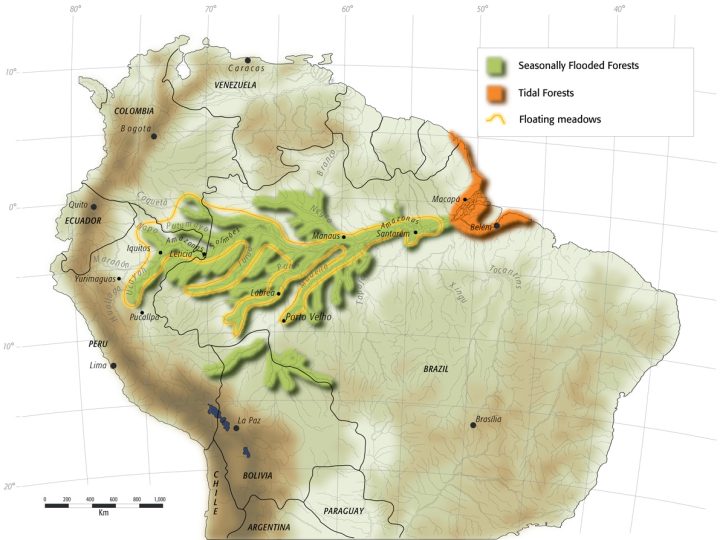
By unifying all records from the Ictio application and the web platform (Ictio.org) up to June 30, 2022, Ictio gathered 90,507 fish observations in 52,202 checklists (fishing events), as result of the work of 574 people and institutions actively participating in the Citizen Science Network for the Amazon and sharing data. This information was generated in 152 Amazon basins that constitute 76% of the total 199 basins at the BL4 level – the fourth of seven hierarchical levels of basin detail according to Venticinque et al. 2016 and A new system of geographical information (SIG) on basins and rivers. It should be noted that the classification was recently updated, this time with 12 levels of basin detail, which can be accessed here.
Users uploaded their data through the Ictio application and the web platform (Ictio.org). We especially highlight the contribution of citizen scientists associated to Ação Ecológica Guaporé (Ecoporé) and the Universidade Federal de Rondônia (UNIR), to Instituto do Desenvolvimento Sustentável Mamirauá (IDSM), and to Instituto del Bien Común (IBC), who made important contributions in the BL4 basins of the Madeira River (upstream of Jamari), the Main Channel of the Amazon/Solimões River (between Juruá and Negro), and the main channel of the Amazon River (upstream of Jandiatuba), respectively.
The activities developed by partner organizations allowed the number of records in the Ictio database to increase, since they are gradually returning to work in the field, always in compliance with the COVID-19 prevention protocols. The number of first-time users of Ictio is also increasing and older users are reconnecting and enjoying the updated version of the application, Ictio 3.1. [link for download 3.0 Version].
In addition, the number of photos also increased. The photos sent through the app are available in the new version of Ictio.org, where access to the photos is free. When using the application, users can authorize their names to be associated with the photographs. And in the case of users who do not want to associate their names with the data and photos, these will be anonymous. Users can change this setting in the main menu of the app, go to Settings, and enter the option Name Associated with your Records, where they can choose whether they would like the public to see their names.
These 90,507 observations shared up to the last quarter in the Ictio application and on the platform (Ictio.org) is equivalent to an increase of 2.83% compared to the previous quarter (January – March 2022: 88,018 observations). The checklists presented an increase of 3.65%, since in the last quarter there were 52,202 checklists and in the previous quarter there were 50,365 checklists.
The number of fish observations shared with the Ictio application and platform per BL4 sub-basin can be seen in Figure 1. The main channel of the Madeira River (upstream of Jamari) stands out with 16,076 fish observacions, followed by the main channel of the Amazonas/Solimoes River Basin (between Juruá and Negro) with 14,785 fish observations.

Figure 1. As of June 30, Ictio registered 90,507 fish observations in 52,202 checklists (fishing events). This information was generated in 152 Amazon basins that account for more than 76% of the total 199 BL4 level basins, the product of the work of 574 individuals and organizations. Data for the period April 2018 to June 2022, accessed on July 1, 2022. Source: Ictio.org Preparation: Wildlife Conservation Society
In addition, 17,559 fish observations were registered with the Ictio application, an increase of 16% over the previous quarter (15,097 fish observations). Figure 2 shows the number of fish observations shared with the Ictio application in each BL4 basin, in which the BL4 basin of the main channel of the Amazon River (above Jandiatuba) is particularly noteworthy.
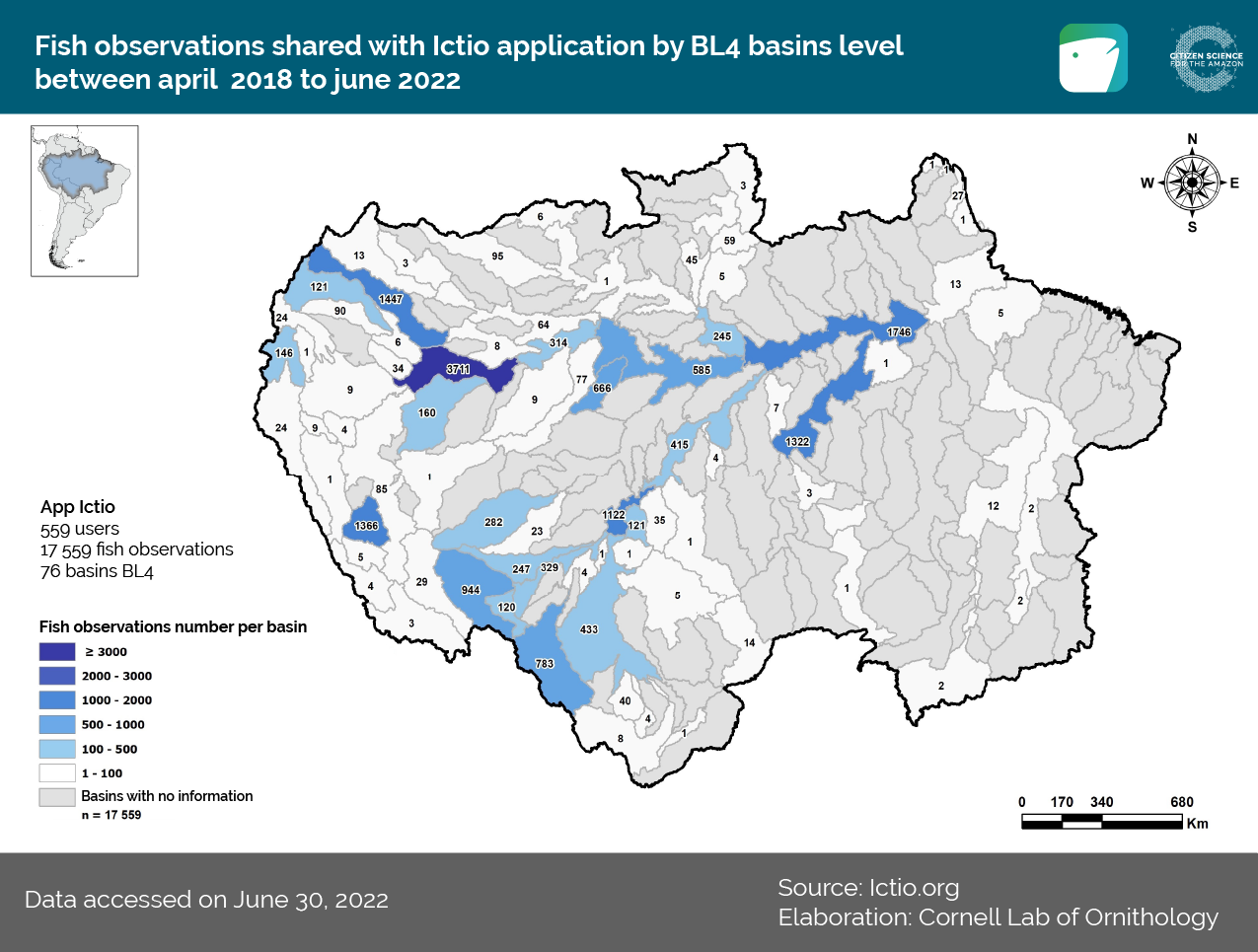
Figure 2. As of June 30, the Ictio application gathered 17,559 fish observations in 10,633 checklists. These data come from 76 BL4 basins. The basin with the highest number of fish observations was Amazonas (upstream ofJandiatuba), with 3,711 fish observations. Data for the period April 2018 to June 2022, accessed on July 1, 2022. Source: Ictio.org Preparation: Wildlife Conservation Society
Figure 3 shows the percentages of observations of Prochilodus nigricans, the fish most recorded by Ictio, uploaded with the application and the platform (Ictio.org). Its presence from headwaters to large rivers is widely known in the Amazon Basin, and the records from the application and the platform (Ictio.org) demonstrate this. It is possible that other species of the genus Prochilodus will be recorded, and it is important to analyze the distribution of data and photographs sent by the app.
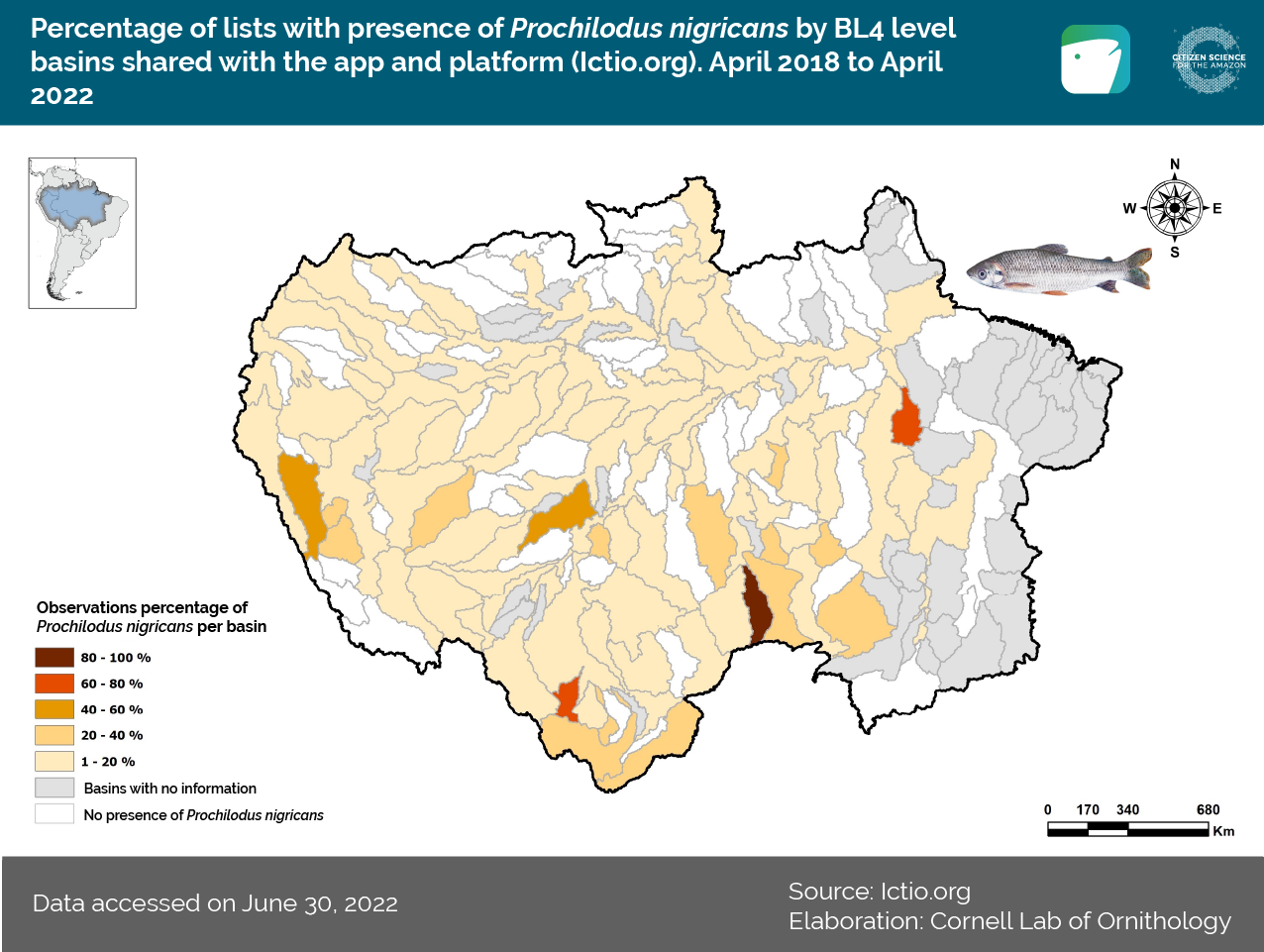
Figure 3. Percentage of checklists from the app and web platform with presence of Prochilodus nigricans (by BL4 level sub-basins. Data for the period April 2018 to June 2022, accessed July 1, 2022. Source: Ictio.org Preparation: Cornell Lab of Ornithology
Between April 2018 and June 2022, Prochilodus nigricans (see common names below) once again stood out as the most observed species by using only the Ictio app. In a ranking of the top 10 species with the most observations (Figure 4), P. nigricans is followed by Triportheus sp. and Mylossoma sp. The number of observations of P. nigricans in this quarter follows the trend of observations in the cumulative data for the app since April 2018, thus remaining the most recorded species since the launch of the app in 2018.
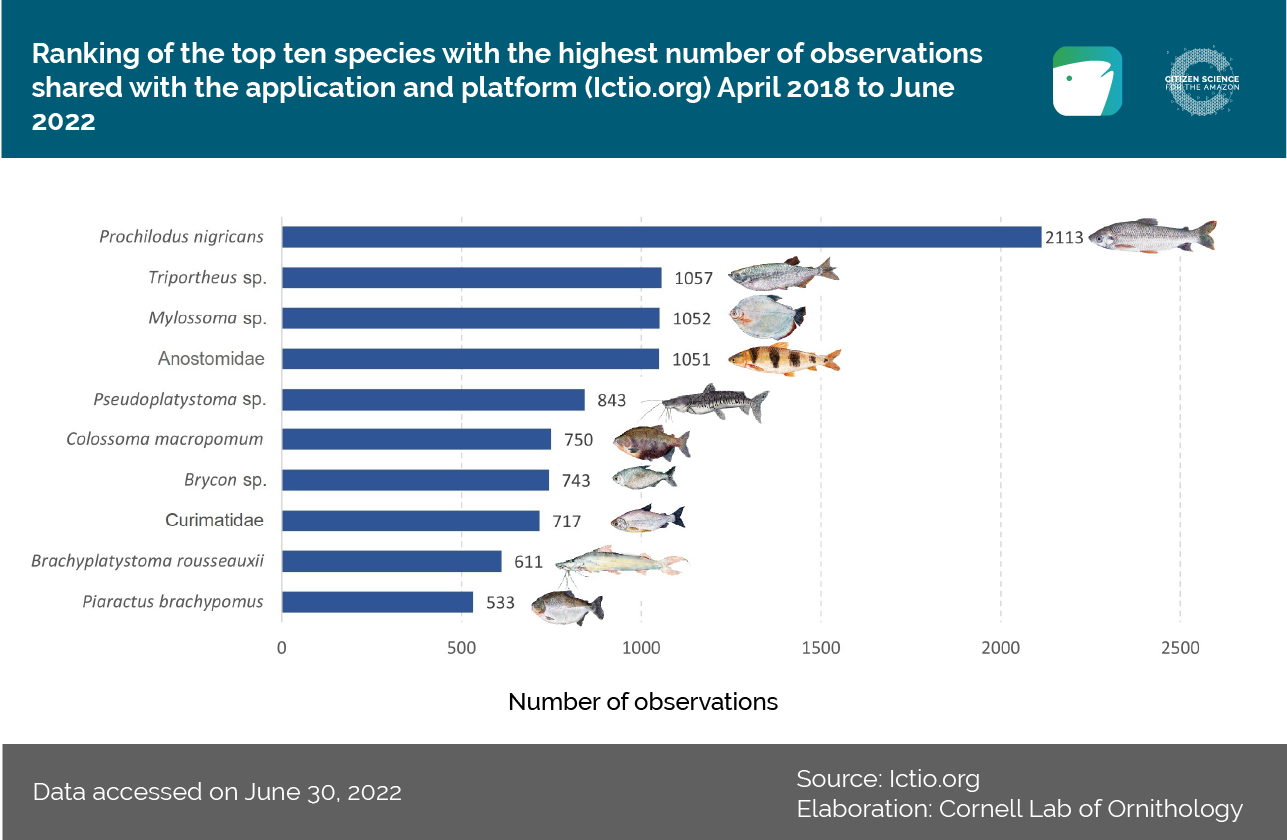
Figure 4. The total number of observations of the top ten most recorded species in the application in the last quarter was 9,470 observations, while adding the observations of all species also in the last quarter, the total was 17,559 observations. For common names, see glossary below. Data for the period April 2018 to June 2022, accessed on July 1, 2022. Source: Ictio.org Preparation: Wildlife Conservation Society
By using the Ictio application, 10,633 checklists were registered between April 2018 and June 2022. The BL4 level basin with the highest number of checklists was the main channel of the Amazon River, upstream of Jandiatuba (Figure 5), between Peru, Brazil and Colombia, followed by the area formed by the main channel of the Amazon River, between the Negro River and the Xingu River in Brazil.
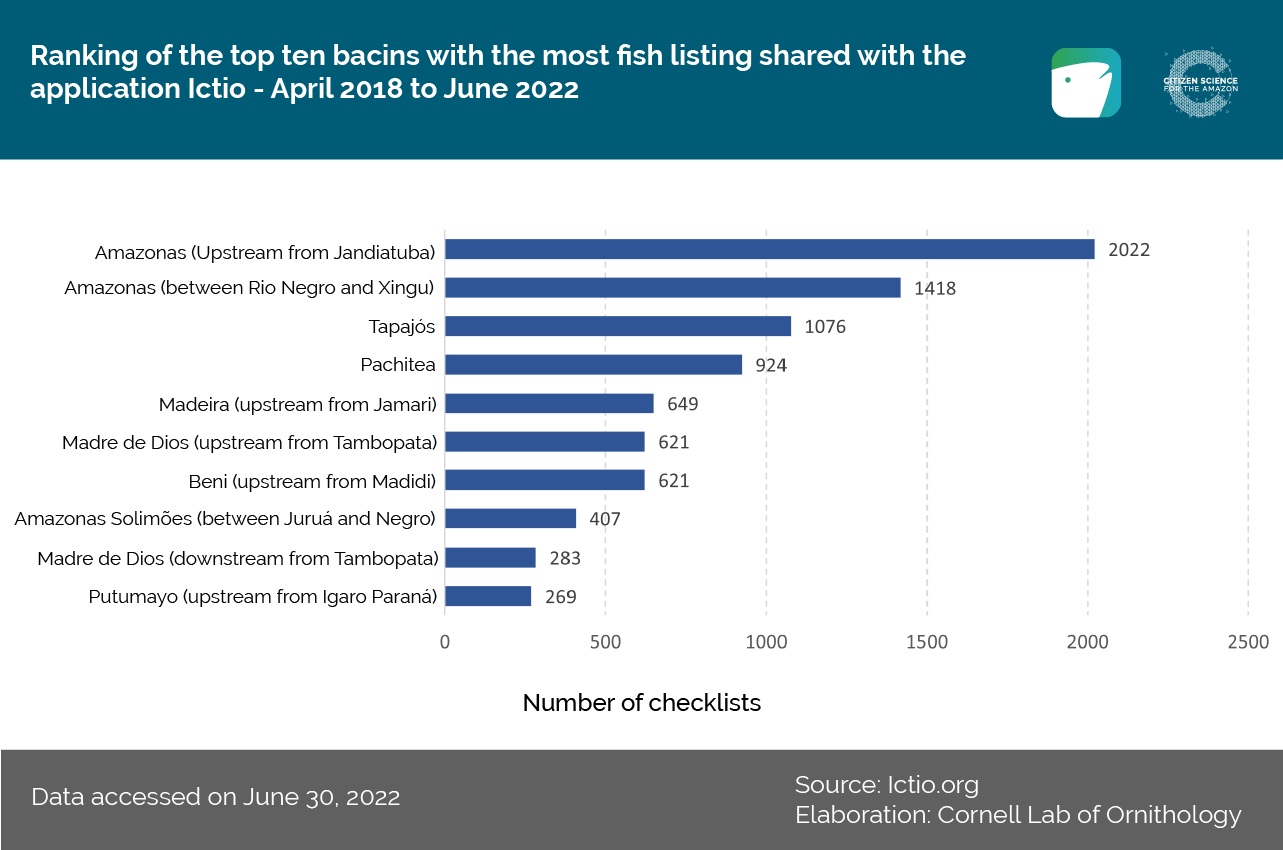
Figure 5. Ranking of the top ten BL4 basins with the highest number of checklists registered with the Ictio application in the last quarter. The graph follows the trend of having the BL4 basin Amazonas (upstream of Jandiatuba) in the first place, which is the basin with the highest number of checklists registered. Data consulted on July 1, 2022. Source: Ictio.org Preparation: Wildlife Conservation Society
Between April 2018 and June 2022, the highest number of citizen scientists using the Ictio application are in the BL4 Beni basin (above Madidi) where WCS Bolivia is leading the implementation of Ictio, followed by scientists in the BL4 Amazonas basin (above Jandiatuba), where IBC partners are coordinating collective activities with fishing communities through fishery monitoring. The most active user registered 387 checklists in the BL4 Amazonas (upstream of Jandiatuba), in Peru. These good results highlight the continuous and productive work of our partners of the Citizen Science Network for the Amazon.
Learn about the most popular families, genera and species and their common names by country!
Anostomidae: Ruta (Bolivia); aracu, aracu cabeça-gorda, piau (Brazil); lisa, cheo, guaracú (Colombia); lisa, tanla (Ecuador); lisa (Peru).
Brachyplatystoma rousseauxii: dorado (Bolivia); dourada (Brazil); plateado, dorado (Colombia); plateado (Ecuador); dorado, zúngaro dorado (Peru).
Brycon sp.: yatorana, mamuri, yaturana, matrinchán (Bolivia); matrinxã, jatuarana (Brazil); sábalo, sabaleta, zingo (Colombia), sábalo, mahuaso, katupa o handia (Ecuador) y sábalo (Peru).
Curimatidae: llorona, branquiña (Bolivia); branquinha (Brazil); llorón, chillón, branquiña (Colombia); sardina (Ecuador); chío chío, yahuarachi, llambina (Peru).
Colossoma macropomum: Pacú, tambaqui (Bolivia), Tambaqui (Brazil), cachama negra, cherna, gamitana (Colombia), paco (Ecuador), gamitana (Peru).
Mylossoma sp: pacupeba (Bolivia), pacu-comum (Brazil), y palometa (Colombia, Ecuador y Peru).
Piaractus brachypomus: Tambaqui, Pacu (Bolivia), Pirapitinga (Brazil), Paco, Cachama blanca (Colombia), Cachama blanca (Ecuador), Paco (Peru).
Prochilodus nigricans: Sábalo (Bolivia); curimatã, curica o papa-terra (Brazil); bocachico (Colombia y Ecuador); challua (Ecuador) y boquichico (Peru).
Pseudoplatystoma sp.: Surubíes (Bolivia), Surubins (Brazil), Pintadillos (Colombia), Pintadillos (Ecuador), Doncella (Peru).
Triportheus sp.: panete (Bolivia), sardinhas (Brazil), sardina (Colombia y Peru), y pechón y sapamama (Ecuador).


